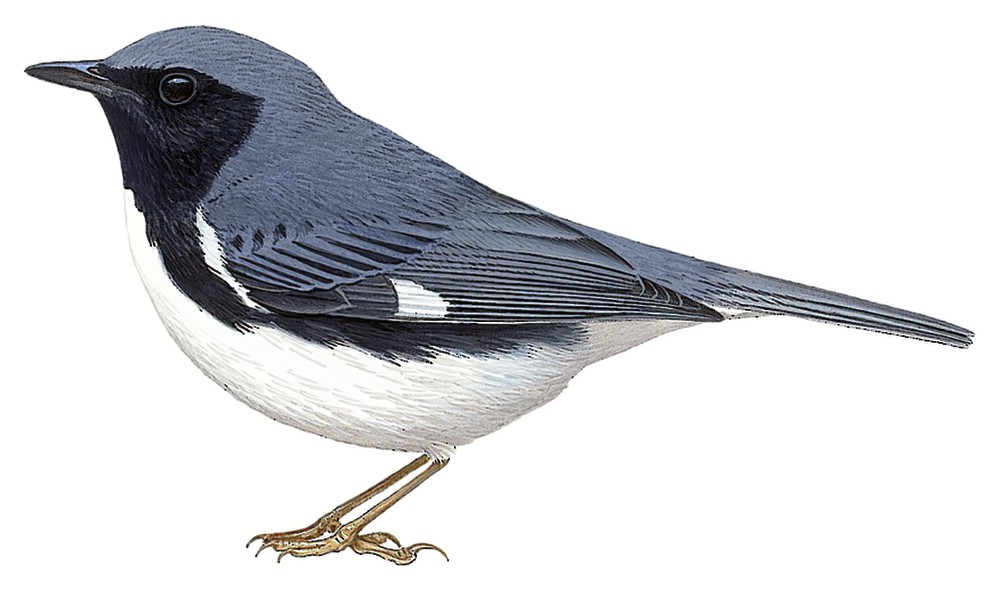Black-throated Blue Warbler / Setophaga caerulescens

Black-throated Blue Warbler
SCI Name:
Protonym: Motacilla caerulescens Syst.Nat. 1 pt2 p.960
Taxonomy: Passeriformes / Parulidae / Setophaga
Taxonomy Code: btbwar
Type Locality: Santo Domingo.
Author: Gmelin, JF
Publish Year: 1789
IUCN Status: Least Concern
DEFINITIONS
SETOPHAGA
(Parulidae; Ϯ American Redstart S. ruticilla) Gr. σης sēs, σητος sētos moth; -φαγος -phagos -eating < φαγειν phagein to eat; "G. SETOPHAGA. Sw. in Zool. Journ. No. 10. 17. Setophaga ruticilla. Muscicapa ruticilla, Lin. mas. M. flavicaudæ. Gm. fem. Maritime parts. 18. Setophaga miniata. Cinereous, breast and body beneath vermilion; tail black, the lateral tail feathers partly white. Table land: woods of Valadolid; rare, size of the last. 19. Setophaga rubra. Entirely red, ear feathers of a silky whiteness. Inhabits the same woods, and is of the same size as the last." (Swainson 1827 (May)); "SETOPHAGA. Rostrum parvum; culmine carinato. Alæ mediocres; remigibus 1ma et 4ta æqualibus, 2da et 3tia æqualibus, longissimis. Cauda sub-elongata, rotundata. Pedes graciles, tarsis squamis anterioribus divisis, lateralibus integris. ... Type. Muscicapa ruticilla. Linn. ... It represents, in the new world, the Australian genus Rhipidura" (Swainson 1827 (July)); "Setophaga Swainson, 1827 (May), Philos. Mag., new ser., 1, fasc. 5, p. 368. Type, by subsequent designation (Swainson, 1827 (July), Zool. Journ., 3, p. 360), Motacilla ruticilla Linnaeus." (Lowery & Monroe in Peters 1968, XIV, 33). Doubtless time will soften the dismay of birdwatchers caused by the absorption of Dendroica, Parula and Wilsonia into Setophaga.
Var. Cetophaga.
Synon. Agreocantor, Azuria, Caeruleocantor, Chloris, Chrysocantor, Compsothlypis, Dendroica, Fruticantor, Lineocantor, Maculocantor, Myioctonus, Myiodioctes, Neodendroica, Parula, Perissoglossa, Piceacantor, Pinacantor, Ruticilla, Sylvania, Sylvicola, Sylviocantor, Sylviparus, Terracantor, Vireocantor, Wilsonia.
caerulescens
Unattested L. caerulescens, caerulescentis bluish (neither caerulescere nor caerulescens have been found in Classical Latin, but their existence may be inferred from caeruleus azure-blue, by the example, amongst others, of rufus red, ruddy, giving rufescere to become reddish, and rufescens reddish).
● "61. ANAS. ... cærulescens. 10. A. grisea, subtus alba, tectricibus alarum dorsoque postico cærulescentibus. Anser canadensis, alis cæruleis. Edw. av. 152. t. 152. Habitat in Canada." (Linnaeus 1758) (Anser).
● "43. LANIUS. ... cærulescens. 8. L. cauda forficata, corpore nigro cærulescente, abdomine albo. Lanius cauda forcipata. Edv. av. 96. t. 56. Habitat in Benghala." (Linnaeus 1758) (Dicrurus).
● ex “Héron bleuâtre de Cayenne” of d’Aubenton 1765-1781, “Crabier bleu à cou brun” of de Buffon 1770-1785, and “Blue Heron” of Latham 1785 (syn. Egretta caerulea).
● ex “Blue Roller” of Latham 1785 (syn. Eurystomus glaucurus).
● "41. FALCO. ... cærulescens. 7. F. cera palpebris pedibus subtusque luteus, dorso nigro-cærulescente, temporibus linea alba inclusis. Accipiter minimus benghalensis. Edv. av. 108. t. 108. Habitat in Asia." (Linnaeus 1758). This epithet is the thirteenth name in avian nomenclature. (Microhierax).
● ex "Oiseau bleu" of Dubois 1671, and "Gros oiseau" of Brown 1724 (‡Porphyrio).
● ex “Blue-necked Rail” of Latham 1785 (Rallus).
● ex "Fauvette bleuâtre de S. Domingue" of de Buffon 1770-1783, and "Blue-grey Warbler" of Latham 1783 (Setophaga).
● ex “Batara negro y aplomado” of de Azara 1802-1805, no. 213 (Thamnophilus).
● ex “Caerulean Creeper” of Latham 1801 (syn. Zosterops lateralis).
SUBSPECIES
Black-throated Blue Warbler (caerulescens)
SCI Name: Setophaga caerulescens caerulescens
caerulescens
Unattested L. caerulescens, caerulescentis bluish (neither caerulescere nor caerulescens have been found in Classical Latin, but their existence may be inferred from caeruleus azure-blue, by the example, amongst others, of rufus red, ruddy, giving rufescere to become reddish, and rufescens reddish).
● "61. ANAS. ... cærulescens. 10. A. grisea, subtus alba, tectricibus alarum dorsoque postico cærulescentibus. Anser canadensis, alis cæruleis. Edw. av. 152. t. 152. Habitat in Canada." (Linnaeus 1758) (Anser).
● "43. LANIUS. ... cærulescens. 8. L. cauda forficata, corpore nigro cærulescente, abdomine albo. Lanius cauda forcipata. Edv. av. 96. t. 56. Habitat in Benghala." (Linnaeus 1758) (Dicrurus).
● ex “Héron bleuâtre de Cayenne” of d’Aubenton 1765-1781, “Crabier bleu à cou brun” of de Buffon 1770-1785, and “Blue Heron” of Latham 1785 (syn. Egretta caerulea).
● ex “Blue Roller” of Latham 1785 (syn. Eurystomus glaucurus).
● "41. FALCO. ... cærulescens. 7. F. cera palpebris pedibus subtusque luteus, dorso nigro-cærulescente, temporibus linea alba inclusis. Accipiter minimus benghalensis. Edv. av. 108. t. 108. Habitat in Asia." (Linnaeus 1758). This epithet is the thirteenth name in avian nomenclature. (Microhierax).
● ex "Oiseau bleu" of Dubois 1671, and "Gros oiseau" of Brown 1724 (‡Porphyrio).
● ex “Blue-necked Rail” of Latham 1785 (Rallus).
● ex "Fauvette bleuâtre de S. Domingue" of de Buffon 1770-1783, and "Blue-grey Warbler" of Latham 1783 (Setophaga).
● ex “Batara negro y aplomado” of de Azara 1802-1805, no. 213 (Thamnophilus).
● ex “Caerulean Creeper” of Latham 1801 (syn. Zosterops lateralis).
Black-throated Blue Warbler (cairnsi)
SCI Name: Setophaga caerulescens cairnsi
cairnsi
● Cairns, northern Queensland, Australia (subsp. Sericornis citreogularis, subsp. Smicrornis brevirostris).
● John Simpson Cairns (1862-1895) US naturalist, collector (subsp. Setophaga caerulescens).
UPPERCASE: current genus
Uppercase first letter: generic synonym
● and ● See: generic homonyms
lowercase: species and subspecies
●: early names, variants, mispellings
‡: extinct
†: type species
Gr.: ancient Greek
L.: Latin
<: derived from
syn: synonym of
/: separates historical and modern geographic names
ex: based on
TL: type locality
OD: original diagnosis (genus) or original description (species)












